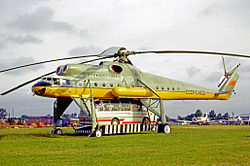Mil Wed-10
| Mil Wed-10 | |
|---|---|
 Mi-10 with LAZ-695 as external load (1965) |
|
| Type: | Transport helicopter |
| Design country: | |
| Manufacturer: | |
| First flight: |
June 15, 1960 |
| Production time: |
1964-1969 |
| Number of pieces: |
63 |
The Mil Mi-10 ( Russian Миль Ми-10 , NATO code name "Harke") was a Soviet cargo helicopter . Compared to comparable designs, it only had a smaller, normal passenger cabin, but was equipped with four high chassis legs so that it could also take a container or other voluminous external loads (e.g. a bus) under itself .
history
Construction began in 1958 after a government decree of February 20 under the designation W-10 (for Wertoljot, helicopter) or Isdelije (product) 60. The work was under the direction of the deputy chief designer N. G. Roosanowitsch. The Mi-6 was the basis for the Mi-10 . The two Solovyov D-25W engines with 5500 WPS each and the R-7 transmission system including rotors were taken over from it. The fuselage, however, was a new design. Large and bulky loads could be hung under the fuselage, such as B. vehicles or containers. To do this, the loads only had to be maneuvered under the hull. With a ground clearance of 3.75 m to the underside of the fuselage and a track width of six meters, this wasn't too much of a problem with most loads. Up to 120 people could be transported in a special container that was fastened under the helicopter. In addition, up to 28 people, mostly assembly personnel for the external load, found space in the fuselage on folding seats in the 19.95 × 1.66 × 2.75 m cargo and passenger cabin. The first thing that was made for testing was a dummy, which was removed in May 1959. The first flight of the first prototype was carried out by German Alferow and Boris Semskow in June 1960. It was destroyed during testing in May 1961 in a crash landing due to a hydraulic failure. With a second prototype, the tests were continued from July of the same year, followed by state acceptance in 1962, which dragged on until 1964. After its successful completion, the state aircraft factory No. 168 in Rostov-on-Don was commissioned with production, and in September of the same year the first series aircraft made its maiden flight.
To determine the maximum load capacity, the Mi-10R was created in 1965 . In this version, the large and heavy main landing gear was replaced by a tripod landing gear of the Mi-6. As a result, the payload increased and the following records were flown on September 23, 1961 with test pilot G. Alferow in the cockpit of the Mi-10R:
- Altitude with 15,000 kg payload: 2,326 m
- Largest payload at an altitude of 2,000 m: 15,103 kg
Another version with a shortened chassis was the crane version Mi-10K (korotkonogii - short-legged, NATO code name "Harke-B"). Thanks to the greatly shortened chassis, the normal payload could be increased from 8,000 kg to 11,000 kg. Under the fuselage there was a cabin for the loadmaster, through which the machine could raise or lower the loads with much more precision. This version was first presented to the public on March 26, 1966 in Moscow . Later Mi-10K received improved D-25WF engines with an output of 6500 WPS (4781 kW) each, which allow external loads of up to 14,000 kg. From 1979 onwards, Aeroflot's Mi-10K were chartered several times and used to erect electricity pylons and industrial plants in the GDR. The last of these missions took place in 1989.
The Mi-10PP was developed for the Soviet armed forces for electronic warfare . It had an external module that contained jammers. These were apparently only ready for use on the ground.
From 1964 to 1969 a total of 63 Mi-10 series machines were built in Rostov-on-Don. Other sources report that only 40 helicopters were built. Most of them were used in various major construction projects in remote areas of the Soviet Union. Occasionally, Soviet or Russian machines were also used abroad, including in the GDR . Only three machines were exported to Iraq .
Technical specifications
| Parameter | Data (Mil Mi-10) | Data (Mil Mi-10K) |
|---|---|---|
| Manufacturer | Rostov State Aircraft Plant No. 168 | |
| Type | Cargo helicopter | Crane helicopter |
| First flight | June 1960 | 1965 |
| crew | 3 | |
| Passengers | 28 | |
| Main rotor diameter | 35.00 m | |
| Main rotor area | 962.11 m² | |
| Hull length | 32.86 m | 35.00 m |
| length | k. A. | 41.89 m |
| height | 9.90 m | 7.80 m |
| Empty mass | 27,300 kg | |
| Max. Take-off mass | 43,700 kg | |
| Max. Mass of the external load | 11,000 kg | |
| drive | 2 × Solowjow -D-25W turbines with 5500 WPS each (4101 kW) | |
| Top speed | 200 km / h | 250 km / h |
| Cruising speed | 170 km / h | k. A. |
| Service ceiling | k. A. | 3000 m |
| Range | 430 km with reserve | |
See also
- List of helicopter types
- Sikorsky S-64 Skycrane
literature
- Nikolai Jakubowitsch: Mil Wed-10. The flying crane . In: Flight Revue . No. 2/2018 , p. 80-83 .
Web links
- Миль Ми-10. Retrieved February 14, 2018 (Russian, Wed-10).
- Миль Ми-10К. Retrieved February 14, 2018 (Russian, Wed-10K).
- Миль Ми-10УПЛ. Retrieved February 14, 2018 (Russian, Wed-10UPL).

